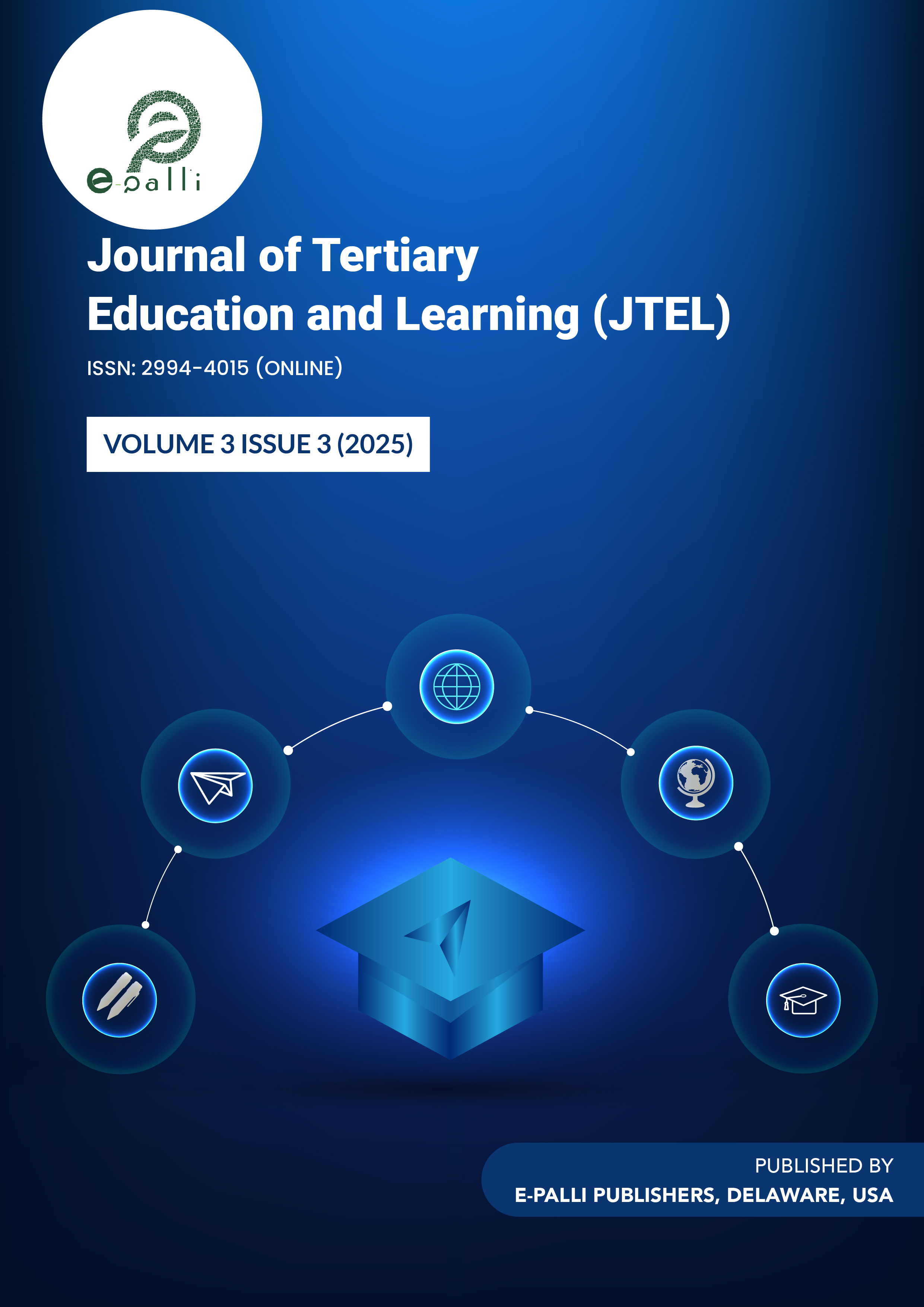Empowering Marginalized Voices: Digital Storytelling as a Tool for Inclusive Higher Education Pedagogy
DOI:
https://doi.org/10.54536/jtel.v3i3.5548Keywords:
Digital Storytelling, Inclusion, Rural Learners, Tertiary Education, Universal Design for LearningAbstract
This study examines the integration of Digital Storytelling (DST) as a Universal Design for Learning (UDL)-aligned pedagogical strategy to enhance inclusion and engagement in higher education for rural, first-generation students in Pakistan. Using a reflective, qualitative case study approach, this research explores DST as a narrative-based, low-tech intervention that amplifies students’ voices and cultural identities. Addressing structural challenges such as linguistic mismatch, digital inequity, and inflexible curricula in public-sector universities, undergraduate students used accessible mobile tools over a five-week period to create personal digital narratives, drawing from UDL’s principles of multiple means of engagement, representation, and expression. Data were collected through student artifacts, reflective journals, and instructor observations. Thematic analysis revealed increased learner agency, emotional resonance, and participation in otherwise passive learning spaces. While based on a small sample, the study provides contextually grounded insights into inclusive pedagogy for under-resourced tertiary institutions. The findings affirm DST’s value as a context-sensitive, inclusive pedagogy in resource-constrained environments. Situated within the framework of Sustainable Development Goal 4 (Quality Education), this study highlights how even small-scale, student-centered interventions can challenge exclusionary structures and promote equitable participation in tertiary education. These findings offer practical implications for educators and policymakers seeking scalable and inclusive teaching strategies in low-resource higher education environments worldwide.
References
Ahmad, M. S., Nawaz, S., Khan, S., & Bukhari, Z. (2023). Digital Pakistan in COVID-19: Rethinking language use at social media platforms. Frontiers in Education, 8, 967148. https://doi.org/10.3389/feduc.2023.967148
Aijaz, R. (2024). Exploring the Impact of DST and Animations on Students’ Science Skills [National University of Science and Technology (NUST)]. https://www.researchgate.net/publication/385078061_Exploring_the_Impact_of_DST_and_Animations_on_Students’_Science_Skills
Alterio, M., & McDrury, J. (2013). Learning Through Storytelling in Higher Education: Using Reflection and Experience to Improve Learning. Taylor and Francis.
Arias, C. R., Calago, C. N. S., Calungsod, H. F. B., Delica, M. A., Fullo, M. E., & Cabanilla, A. Jr. B. (2023). Challenges and Implementation of Inclusive Education in Selected Asian Countries: A Meta-Synthesis. International Journal of Research in Education and Science, 9(2), 512–534. https://doi.org/10.46328/ijres.3089
Austen, L., Pickering, N., & Judge, M. (2021). Student reflections on the pedagogy of transitions into higher education, through digital storytelling. Journal of Further and Higher Education, 45(3), 337–348. https://doi.org/10.1080/0309877x.2020.1762171
Braun, V., & Clarke, V. (2006). Using thematic analysis in psychology. Qualitative Research in Psychology, 3(2), 77–101. https://doi.org/10.1191/1478088706qp063oa
CAST. (2018). CAST [CAST Professional Publishing]. The UDL Progression Rubric [PDF]. https://publishing.cast.org/stories-resources/book-product-resources/udl-progression-rubric-novak-rodriguez
Dutta, T., & Keith, C. (2023). Evolution of storytelling pedagogy in global health course at a U.S. Native American-Serving Nontribal Institution from Fall 2019 to Spring 2023. Frontiers in Public Health, 11. https://doi.org/10.3389/fpubh.2023.1165241
Fletcher, S., & Mullett, J. (2016). Digital stories as a tool for health promotion and youth engagement. Canadian Journal of Public Health = Revue Canadienne De Sante Publique, 107(2), e183–e187. https://doi.org/10.17269/cjph.107.5266
Gallego, J. G. D. (2023). Universal Design for Learning: Its Impact on Enhanced Performance. Journal of Tertiary Education and Learning, 1(1), 27–41. https://doi.org/10.54536/jse.v1i1.1477
HEC. (2024). Revised Education Curriculum. HEC Pakistan. https://www.hec.gov.pk/english/services/universities/RevisedCurricula/Documents/2024-2025/EDUCATION.pdf?utm_source=chatgpt.com
Javed, H., Hussain, M. A., & Tufail, M. (2024). Effect of Universal Design for Learning (UDL) Embedded Project on 5th Grade Students’ Academic Achievement in Science Subject. Bulletin of Education and Research, 46(2), 93–106.
Lambert, R. (2021). The Magic Is in the Margins: UDL Math. Mathematics Teacher: Learning and Teaching PK-12, 114(9), 660–669. https://doi.org/10.5951/mtlt.2020.0282
Lv, Y., Ni, W., & Tan, Y. (2024). An Overview of Research on Multimodal Teaching and Learning. Journal of Education and Educational Research, 8(3), 492–495. https://doi.org/10.54097/qp4jg551
Meyer, A., Rose, D. H., & Gordon, D. (2014). Universal design for learning: Theory and practice. CAST Professional Publishing, an imprint of CAST, Inc.
Moriña, A., Carballo, R., & Doménech, A. (2025). Transforming higher education: A systematic review of faculty training in UDL and its benefits. Teaching in Higher Education, 1–18. https://doi.org/10.1080/13562517.2025.2465994
Nair, V., & Md Yunus, M. (2022). Using Digital Storytelling to Improve Pupils’ Speaking Skills in the Age of COVID 19. Sustainability, 14(15), 9215. https://doi.org/10.3390/su14159215
Ng-A-Fook, N., Radford, L., Yazdanian, S. N., & Norris, T. (2013). Empowering Marginalized Youth: Curriculum, Media Studies, and Character Development. The Canadian Journal of Action Research, 14(1), 38–50. https://doi.org/10.33524/cjar.v14i1.71
Phan, D. K., Nguyen, T. T., Nguyen, T. T., & Ngoan, V. K. (2025). Applying UDL to Blended Learning: A Case Study of The Latin American Literature Course. Journal of Tertiary Education and Learning, 3(2), 35–45. https://doi.org/10.54536/jtel.v3i2.4617
Priyadharsini, V., & Sahaya Mary, R. (2024). Universal Design for Learning (UDL) in Inclusive Education: Accelerating Learning for All. Shanlax International Journal of Arts, Science and Humanities, 11(4), 145–150. https://doi.org/10.34293/sijash.v11i4.7489
Riessman, C. K. (2008). Narrative methods for the human sciences. Sage Publications.
Strayhorn, T. L. (2019). College students’ sense of belonging: A key to educational success for all students (Second edition). Routledge.
Thomas, S., & Manalil, P. (2025). Digital storytelling and the pedagogy of belonging: Reimagining inclusion in higher education. Frontiers in Communication, 10. https://doi.org/10.3389/fcomm.2025.1630596
UNESCO. (2019). SDG 4 Data Digest How to Produce and Use the Global and Thematic Education Indicators. UNESCO. https://uis.unesco.org/sites/default/files/documents/sdg4-data-digest-2019-en_0.pdf
Yin, R. K. (2018). Case study research and applications: Design and methods (Sixth edition). SAGE.
Downloads
Published
How to Cite
Issue
Section
License
Copyright (c) 2025 Rukhma Aijaz

This work is licensed under a Creative Commons Attribution 4.0 International License.






